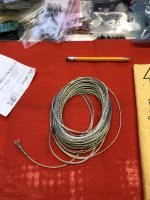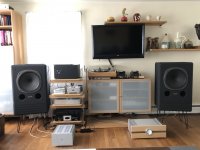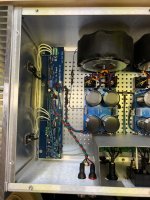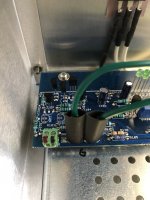Also, why aren’t the RCA jacks as close as possible to the amp board inputs?
It looks like the RCAs are next to incoming AC power!
To a lesser degree, the speaker jacks don’t need to be near the incoming power either.
It looks like the RCAs are next to incoming AC power!
To a lesser degree, the speaker jacks don’t need to be near the incoming power either.
well, that too, as general rule
(I was more thinking of difference between two builds)
anyway, he's young, still time to learn

(I was more thinking of difference between two builds)
anyway, he's young, still time to learn

LOL!…not sure…a lot of learning, maybe not enough time.
The positioning of the RCA inputs and speaker binding posts is due to using a Modushop 4U/400 case I purchased after starting this build as a template for the back of my cases…what could be better right?
Unfortunately…the larger power inlet combined with the desire to build dual mono supplies in what is essentially my equivalent to only a Modushop 4U/300 case required compromises when realizing I needed to modify the back panel to also incorporate seperate fusing for each supply.
The result was everything got crowded I tried compensating by enclosing the incoming AC with a galvanized steel shielding box. It is what it is now.
One amp is perfectly quiet like this…one would hope this was possible with both.
I’ll take a look at the input wiring…can’t remember if the noise lessened while I was fiddling with it. I did shorten it and twist it as much as my clumsy hands would allow inside the case.
BTW…I have some Mogami Neglex 2549 for RCA cables I haven’t built yet…hwould that be for input wiring?…assuming I’d attach shielding only at one end at the RCA input socket?
Thanks guys
The positioning of the RCA inputs and speaker binding posts is due to using a Modushop 4U/400 case I purchased after starting this build as a template for the back of my cases…what could be better right?
Unfortunately…the larger power inlet combined with the desire to build dual mono supplies in what is essentially my equivalent to only a Modushop 4U/300 case required compromises when realizing I needed to modify the back panel to also incorporate seperate fusing for each supply.
The result was everything got crowded I tried compensating by enclosing the incoming AC with a galvanized steel shielding box. It is what it is now.
One amp is perfectly quiet like this…one would hope this was possible with both.
I’ll take a look at the input wiring…can’t remember if the noise lessened while I was fiddling with it. I did shorten it and twist it as much as my clumsy hands would allow inside the case.
BTW…I have some Mogami Neglex 2549 for RCA cables I haven’t built yet…hwould that be for input wiring?…assuming I’d attach shielding only at one end at the RCA input socket?
Thanks guys
do with coax shielding whatever you want, as long it is silent
first try conservative, shield connected on both ends
again, same buzz in both channels?
difference in shorted inputs vs. preamp connected?
please, discount those tube preamps with schyzo nature, I'm asking for preamp being non hissy with first BJ2
first try conservative, shield connected on both ends
again, same buzz in both channels?
difference in shorted inputs vs. preamp connected?
please, discount those tube preamps with schyzo nature, I'm asking for preamp being non hissy with first BJ2
Essentially I would say yes…the tone could be slightly different between channels (could be me)…level of buzz seemed slightly higher in right channel on bench…hooked up to my quiet DCB1 in sunroom system that seemed to reverse…slightly more prominent in left channel…regardless I would say source of buzz is the same in both channelsagain, same buzz in both channels?
Besides what I noted anove with higher level of buzz switching from left to right…I can’t discern a difference between shorted inputs and connection to DCB1 regarding buzzzzzzdifference in shorted inputs vs. preamp connected?
Playing inside touching input wires on bench resulted in louder buzz
When connected to DCB1 touching input wires didn’t have any real affect I could note
There was a alight tone change when I wrapped my hand around speaker output wires…no decrease in buzz
Now that I shortened DC power wires it is harder to shift them. However, again when I push them down to contact base of case and towards/under amp boards the buzz decreases.
P.S. I have some shielding braid I could try sleeving either DC supply wires or input/ouput wiring with and grounding the sleeve. Worth the effort?
Attachments
Last edited:
just put coax cable from input RCA to pcb, screen grounded on both ends
if that is not sufficient, well ...... drill time
someone here started completely wrong ......and got lucky with first one done in same fashion

if that is not sufficient, well ...... drill time
someone here started completely wrong ......and got lucky with first one done in same fashion

🤦♂️🤷♂️😳
No excuses…I like big things in little packages 😁
Should have used these cases for SissySIT monoblocks…or maybe a UMS mounted board like the Aleph J I still haven’t built (actually these BJ2 are UMS, I just got lazy drilling and tapping heatsinks…and the boards were a bit too long for the cases) for that matter I could have done single power supplies and had more room in cases since they’re being used to bi-amp one speaker each I’d still have good channel separation…sigh
No excuses…I like big things in little packages 😁
Should have used these cases for SissySIT monoblocks…or maybe a UMS mounted board like the Aleph J I still haven’t built (actually these BJ2 are UMS, I just got lazy drilling and tapping heatsinks…and the boards were a bit too long for the cases) for that matter I could have done single power supplies and had more room in cases since they’re being used to bi-amp one speaker each I’d still have good channel separation…sigh
Last edited:
well, only you can tell which one to build ..... next 
monoblocks ...... having same channel OS parts on same heatsink ( at least side, speaking of 400deep Modu which have 2 heaatsink in line) is nice ..... wiring and better thermal stability
though, doable with spaghetti , why not, done zillion times

monoblocks ...... having same channel OS parts on same heatsink ( at least side, speaking of 400deep Modu which have 2 heaatsink in line) is nice ..... wiring and better thermal stability
though, doable with spaghetti , why not, done zillion times
Well, one thing I realized my Audible Dillusions pre is still good for…
Impromptu amp comparisons when one of your matching amps is on the work bench, both your systems are in pieces and you just want to hear some music!
Actually…first thing I discovered was my patch cables were set up wrong for left/right comparison…which gave me the opportunity to play with gain levels between the high/low sections of the Tannoys
The Tannoy crossover is set to “level”. I tried bringing the volume up on the woofer since I’m using both pairs of outputs on the AI to biamp and don’t have my sub being fed a signal.
To be honest, I didn’t feel there was an improvement and actually liked the levels matched between the high/low sections.
I changed the wiring so I could match gain between the VFET amp and the BJ2 by centering the stereo image by ear from my listening position on the couch with the left and right volume pots.
After flip flopping back and forth several times between left and right channels with the volume controls the only real conclusion I came to was that both amps sound wonderful.
If pressed for an observation, I would say the VFET does give the impression of being a little more forward…a closer feeling. There is a lot of “air” in the notes being cast into the room…your left with an intimate feeling with the music.
The all IRFP version of the BJ2 gives off a darker more ambient feel…as if the sound is being cast around a concert hall…perhaps that is part of the recording I’m not picking up from the VFET.
This is my morning playlist of classical guitar by David Russell playing.
Anyway…just sharing a little BJ2 related fun.
👍
Impromptu amp comparisons when one of your matching amps is on the work bench, both your systems are in pieces and you just want to hear some music!
Actually…first thing I discovered was my patch cables were set up wrong for left/right comparison…which gave me the opportunity to play with gain levels between the high/low sections of the Tannoys
The Tannoy crossover is set to “level”. I tried bringing the volume up on the woofer since I’m using both pairs of outputs on the AI to biamp and don’t have my sub being fed a signal.
To be honest, I didn’t feel there was an improvement and actually liked the levels matched between the high/low sections.
I changed the wiring so I could match gain between the VFET amp and the BJ2 by centering the stereo image by ear from my listening position on the couch with the left and right volume pots.
After flip flopping back and forth several times between left and right channels with the volume controls the only real conclusion I came to was that both amps sound wonderful.
If pressed for an observation, I would say the VFET does give the impression of being a little more forward…a closer feeling. There is a lot of “air” in the notes being cast into the room…your left with an intimate feeling with the music.
The all IRFP version of the BJ2 gives off a darker more ambient feel…as if the sound is being cast around a concert hall…perhaps that is part of the recording I’m not picking up from the VFET.
This is my morning playlist of classical guitar by David Russell playing.
Anyway…just sharing a little BJ2 related fun.
👍
Attachments
FWIW, I recall encountering a bit of hiss in my BFJ2 back when I built it. Used the 4U/300. It simply ended up being an issue of better wire routing on my part. It wasn’t as forgiving as some other amps I’ve built, but the sound was totally worth it.
Well I’m still exploring my JFETish right now.
This all started after I built my first “real” First Watt amp…the F2J…I fell in love with it.
Before that I had used a an LM3875 gainclone, a Counterpoint Sa12 ( I fried a channel on 🤦♂️) an old Denon integrated and my Quicksilver Horn Monos.
There was no going back from the F2J with the fullrange drivers I was using…it really sucked me into the whole high efficiency scene.
Later on today I’ll be hooking my F2J monoblocks up to one channel of the Tannoys and doing a similar comparison with the BJ2.
I might even throw my ACAs on one channel (they’ve got Semisouth down in them as well).
This all leads to my next iteration of BJ2 with Semisouth down…and possibly a full Semisouth version.
What’s next?…well I have F3, LuDef, SissySIT, Aleph J and Aleph 60 provided for and ready to build.
I can twin most except the SissySIT which is version 1…would have to order a second LuDef…same with another Aleph 60…but I sort of envisioned most of these as monoblocks.
If I was really gonna pursue my JFETish to the end…I’d either need an official blessed circuit from Papa on the J2 or F8…not sure that’s ever coming. I did put aside two pair of curve traced Semisouth and some J109 in case that day ever appears.
I do see this leading ro a VFETish…already built the first version obviously…I’ve got a 2016 kit I picked up in the swap meet and hoarded extra th51s…its the next logical step as “V” comes after “J” 😁
This all started after I built my first “real” First Watt amp…the F2J…I fell in love with it.
Before that I had used a an LM3875 gainclone, a Counterpoint Sa12 ( I fried a channel on 🤦♂️) an old Denon integrated and my Quicksilver Horn Monos.
There was no going back from the F2J with the fullrange drivers I was using…it really sucked me into the whole high efficiency scene.
Later on today I’ll be hooking my F2J monoblocks up to one channel of the Tannoys and doing a similar comparison with the BJ2.
I might even throw my ACAs on one channel (they’ve got Semisouth down in them as well).
This all leads to my next iteration of BJ2 with Semisouth down…and possibly a full Semisouth version.
What’s next?…well I have F3, LuDef, SissySIT, Aleph J and Aleph 60 provided for and ready to build.
I can twin most except the SissySIT which is version 1…would have to order a second LuDef…same with another Aleph 60…but I sort of envisioned most of these as monoblocks.
If I was really gonna pursue my JFETish to the end…I’d either need an official blessed circuit from Papa on the J2 or F8…not sure that’s ever coming. I did put aside two pair of curve traced Semisouth and some J109 in case that day ever appears.
I do see this leading ro a VFETish…already built the first version obviously…I’ve got a 2016 kit I picked up in the swap meet and hoarded extra th51s…its the next logical step as “V” comes after “J” 😁
Last edited:
OK…half hearted attempt to get back to solving noise problem with second BJ2…been too busy playing with Sonidos.
Started working by confirming noise on both channels by firing up only one donut at a time. It’s on both.
Focused on powering one channel to see if I could make progress and compare with other channel.
Anyway, I need to test some of my monkey logic on you electronics genius’.
I was begrudgingly sticking hands inside case to start changing out input wiring…then it popped in my mind to test amp for noise once input wires were disconnected…same noise present.
Does this mean input wiring is NOT responsible for noise?
Secondly…while poking around I again noticed moving DC wiring connecting to amp boards changed/reduced noise.
I decided to take a previous suggestion from BenMah(?) on first BJ2 noise issue…I extended the ground wire so it could be twisted with the DC +/- rail wires all the way to their amp board connectors…then ran ground wire to its ground connector on amp board.
Didn’t solve noise…might have reduced it.
I tested input ground resistance to the chassis as well as other two ground points on amp board to see that CL60 was good as had been suggested on first amp.
Left channel gave me 14.5 Ohms, right channel gave me 12.5 Ohms. Not sure why there’s a difference. CL60 I used are specified to be 10 Ohm 6 Amp.
Pulled the chassis star ground off at IEC inlet to see if the IEC was grounded at mounting points as well and maybe creating a ground loop?(read about in other noise issue thread). No ground to chassis at IEC when wire was pulled.
Tested for noise when chassis star ground cable was disconnected. Still there…maybe worse.
Not sure where to go from here.
Is there a way to hook up my computer with REW installed and test the frequency of the noise coming out of the amp?
Started working by confirming noise on both channels by firing up only one donut at a time. It’s on both.
Focused on powering one channel to see if I could make progress and compare with other channel.
Anyway, I need to test some of my monkey logic on you electronics genius’.
I was begrudgingly sticking hands inside case to start changing out input wiring…then it popped in my mind to test amp for noise once input wires were disconnected…same noise present.
Does this mean input wiring is NOT responsible for noise?
Secondly…while poking around I again noticed moving DC wiring connecting to amp boards changed/reduced noise.
I decided to take a previous suggestion from BenMah(?) on first BJ2 noise issue…I extended the ground wire so it could be twisted with the DC +/- rail wires all the way to their amp board connectors…then ran ground wire to its ground connector on amp board.
Didn’t solve noise…might have reduced it.
I tested input ground resistance to the chassis as well as other two ground points on amp board to see that CL60 was good as had been suggested on first amp.
Left channel gave me 14.5 Ohms, right channel gave me 12.5 Ohms. Not sure why there’s a difference. CL60 I used are specified to be 10 Ohm 6 Amp.
Pulled the chassis star ground off at IEC inlet to see if the IEC was grounded at mounting points as well and maybe creating a ground loop?(read about in other noise issue thread). No ground to chassis at IEC when wire was pulled.
Tested for noise when chassis star ground cable was disconnected. Still there…maybe worse.
Not sure where to go from here.
Is there a way to hook up my computer with REW installed and test the frequency of the noise coming out of the amp?
Attachments
if you close your fingers around mosfet wires, is there change in noise level?
now, when you said that you tried without input wires, did you shorted both inputs to GND, locally on pcb?
now, when you said that you tried without input wires, did you shorted both inputs to GND, locally on pcb?
No change in noise playing with mosfet wires…even tried bending them down more toward gap between heatsink and pcb.
I tested with input wire disconnected…as well as with tiny jumper shorting at input wire block…noise the same as with input wires connected.
I tested with input wire disconnected…as well as with tiny jumper shorting at input wire block…noise the same as with input wires connected.
Attachments
one test more:
last two either solo or twisted where you can meet them
- positive and negative rail as twisted fat wire pair from Cap Bank pcb to channel pcb
- thin GND wire solo to channel pcb
- fat GND wire from Cap Bank pcb to negative output terminal
- fat wire from channel pcb to positive output terminal
last two either solo or twisted where you can meet them
When you play with the ground wire from PSU to amp, do you notice changes? I recall getting improvement when I routed my ground wire tight, parallel and behind the board.
I was able to see my noise in REW
I was able to see my noise in REW
Last edited:
The wiring looks good. Can't see the AC wires but I assume that the live and neutral are tightly twisted and they run down the middle of the case.
Rotating the transformers may help. There is usually a position of minimum noise.
Also all of the amplifiers, preamp, and source should be plugged into the same wall outlet, and bundle all of the AC cords together.
As a last resort, drill new holes in the back plate to locate the input and speaker connectors far away from the AC.
Rotating the transformers may help. There is usually a position of minimum noise.
Also all of the amplifiers, preamp, and source should be plugged into the same wall outlet, and bundle all of the AC cords together.
As a last resort, drill new holes in the back plate to locate the input and speaker connectors far away from the AC.
Last edited:
- Home
- Amplifiers
- Pass Labs
- Babelfish ᄅſ....or FW J2 on Steroids .... or Not your Father's J2!




